| PV
Basics |
| Step One -- Avoid the
scams |
There are some very heavily advertised guides for
sale on the Internet in the $50 range that promise that you can make
PV panels that will provide "80%" of your homes power for a couple
hundred dollars.
You can be sure that anyone making these kinds of claims is a
scammer -- don't waste your money. You will find plenty of free and
honest information below for reputable sources. |
| Solar
Site Survey ...
The Site Survey is particularly critical for PV projects.
|
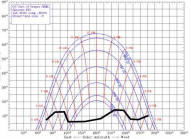 Before you embark on any of
the solar projects listed below, you MUST do a solar site survey. Before you embark on any of
the solar projects listed below, you MUST do a solar site survey.
This will ensure that you actually get enough sun on your collector
to make it worthwhile.
It only takes an hour, its fun, its easy and you will learn
something about how the sun moves. Solar
Site Survey... |
| A Consumers Guide to Buying
A Solar Electric System
EERE PV Guide (pdf)
|
 A consumer guide for selecting a PV
system. Quite a bit of useful information whether you intend to
have the system installed, or install it yourself. A consumer guide for selecting a PV
system. Quite a bit of useful information whether you intend to
have the system installed, or install it yourself. |
|
A couple basics articles from Home Power:
Solar Electricity Basics:
http://www.homepower.com/basics/solar/
Solar-Electric Systems Simplified,
How to get articles from
Home Power ...
Scott Russell, issue 104
|
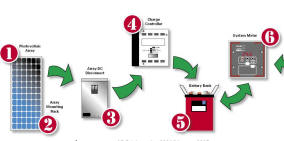 A couple of introductory
articles from Home Power magazine A couple of introductory
articles from Home Power magazine
A very basic description of each of the different styles of PV
systems (grid intertied, off-grid, …). |
Solar Power 101,
Jeffrey Yago, Backwoods Home Magazine, 3 parts starting in May 2004
issue.
Solar Power 101, part 1...
There are two more parts in the following 2 issues. |
 This
is a set of articles by Jeff Yago that goes through the basics of
designing and installing a solar electric system. This
is a set of articles by Jeff Yago that goes through the basics of
designing and installing a solar electric system. |
|
Renewable Energy Design Guide and Catalog
aee solar design guide and catalog...
Fill in the form to download the 270 page design guide and
catalog.
|
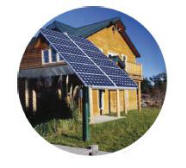 This is a very helpful reference and
catalog for renewable energy systems. It covers PV, wind and small
hydro with emphasis on PV. This is a very helpful reference and
catalog for renewable energy systems. It covers PV, wind and small
hydro with emphasis on PV.
Right up to date and with lots of information on PV system
components and lots of good reference material.
|
| Home Power Magazine
www.HomePower.com
How to get articles
from Home Power ...
|
 Home Power magazine has published many
articles on PV basics, PV systems, and PV components. Home Power magazine has published many
articles on PV basics, PV systems, and PV components.
Home Power is a very good source for hands-on PV information.
|
PVWatts -- A Performance
Calculator for Grid-Connected PV Systems
From NREL
PVWatts Version 1...
This is a really useful tool
I find Version 1 to be the most useful, but if you want to try
the other versions, just Google PVWatts.
|
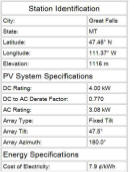 An easy calculator you can use to find
out how much power you will get from a PV installation in your
area. Also very helpful for panel aiming studies. An easy calculator you can use to find
out how much power you will get from a PV installation in your
area. Also very helpful for panel aiming studies.
It calculates PV system performance based on hour by hour records
for sun in your area.
Version 1 is very easy to use, and works worldwide.
Version 2 allows more detailed inputs, but seems rather complex
and puzzling at times to me.
|
| BP PV
System Economics Calculator
http://bpsolar.cleanpowerestimator.com/bpsolar.htm
|
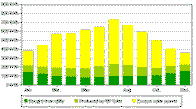 This appears to be a good
tool for estimating the economic return for installing a PV system
for your area. This appears to be a good
tool for estimating the economic return for installing a PV system
for your area.
Allows you to change location, size & cost of array, and
financing.
Shows details on power output, cost savings, and return on your
investment.
While it is offered by a company selling PV equipment, it does not
appear (to me) to be overly optimistic on power generated or
savings. |
| PVGIS
-- PV sizing tool for Europe and Africa
PVGIS sizing tool:
http://re.jrc.ec.europa.eu/pvgis/apps3/pvest.php#
PVGIS home page:
http://re.jrc.ec.europa.eu/pvgis/
|
 Very nice PV array sizing
tool and solar radiation tool for Europe and Africa. Very nice PV array sizing
tool and solar radiation tool for Europe and Africa.
Includes effects of local weather, obstructions, ...
|
| Taking
the Plunge! An Off-the-Grid Home Tour to Learn the Basics of a
Renewable Energy System, William Kemp (pdf)
|
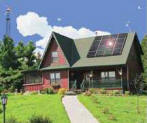 A good primer
on what's involved in planning for an living in an off-grid home
with solar electricity generation. A good primer
on what's involved in planning for an living in an off-grid home
with solar electricity generation.
A lot of emphasis on the conservation steps needed to get demand
down. Not a lot of hands-on, but a very good introduction. |
| Backwoods Solar Catalog
www.BackWoodsSolar.com
|
 The printed version of the
Backwoods Solar Catalog has a lot of good educational and reference
material. Available on request from their website. The printed version of the
Backwoods Solar Catalog has a lot of good educational and reference
material. Available on request from their website. |
|
Simpler Solar Power – Grid-Tied Solar Systems
Make Choosing Clean, Renewable Electricity Easier and More
Affordable Than Ever
Mother Earth News
Doug Liningston and Scott Hollis
Finding
Mother Earth News articles...
|
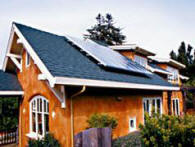 Mother Earth
News Article Mother Earth
News Article
Good article explaining the basics of grid-tied PV systems. Not
a lot of “how-to”, but good explanation of the basics.
|
|
Plug into the Sun
Rusty Haunes and Lindsey Hodel
Finding Mother
Earth News articles...
|
Mother Earth News Article,
Issue 199
This article provides an overview of the financial aspects of
building a solar PV system. Concentrates primarily on obtaining
government grants to reduce the cost of the system.
|
| List
of good discussion forums...
|
This is a list of discussion forums I
like. You can post questions on these forums and get answers. As
always on the Internet, the level of expertise varies from very high
to very very low, so be careful to confirm the advice you get in
some way. |
| What is the actual output
from a "1 KW" PV rig?
Home Energy Magazine article
www.homeenergy.org (pdf)
|
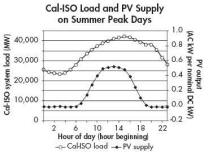 So, how much output will a
(say) 1 KW rated PV setup produce? This Home Energy Magazine
article reports actual measurements for 19 real PV systems. So, how much output will a
(say) 1 KW rated PV setup produce? This Home Energy Magazine
article reports actual measurements for 19 real PV systems. |
| Wind Sun
www.windsun.com/General/Library_Index.htm
|
Solar electric library and buyers guide.
Quite a few downloadable PV equipment specs, brochures, manuals. |
| PhotoVoltaics: Design and
Installation Manual |
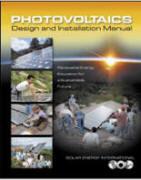 A very good and detailed
reference on designing and installing PV systems -- the best that I
know of. A very good and detailed
reference on designing and installing PV systems -- the best that I
know of.
About $60.
|
A Guide To Photovoltaic (PV)
System Design and Installation,
California Energy Commission, 2001
http://www.energy.ca.gov (pdf)
|
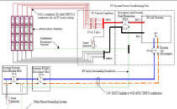 A lot of helpful and fairly detailed
information on planning, designing, and installing a PV system that
is safe and meets codes. A lot of helpful and fairly detailed
information on planning, designing, and installing a PV system that
is safe and meets codes.
Provides information on sizing, wiring, component selection, ...
Also, provides a detailed check list.
Some of the information is specific to California installations,
but most id broadly applicable.
|
| 1BOG --
one block off the the grid -- group discount program
http://1bog.org/
|
 The 1BOG organization puts together a
group of people in a city who want to install PV systems, and
negotiates a group discount. The 1BOG organization puts together a
group of people in a city who want to install PV systems, and
negotiates a group discount.
It seems like a potentially good concept that is worth looking
into. If you have had a good (or bad) experience with the
program, please let
me know...
(Thanks to Michelle for suggesting this)
|
| Leasing PV Systems
|
There are companies that
will lease you a PV system to mount on your house. They make the
deal sound very attractive. I have zero expertise on this, but
this article says there are some large potential gotcha's in the
fine print... So, be very very careful.
On the other hand,
this NREL analysis finds at least some of the lease programs
to be more attractive than other forms of ownership...
My alternative thought would be to look at the Half
Plan, and do the energy saving projects that will cost you
little and save you a lot -- then, buy your PV system from the
savings on other projects. Our
experience with PV economics compared to other energy project
economics...
|
Emissions from Photovoltaic Life Cycles,
Vasilis Fthenakis, Huung Chul Kim, and Erik Alsema,
ASAP Environ. Sci. Technol, Feb 200
The Energy Blog article this came from ...
|
Every once in a while you still find
people saying that the energy and pollution involved in making PV
cells exceeds the energy use or pollution they prevent during their
life. This is completely and totally false -- here is the latest
paper verifying this.
Conclusion of the study:
"Using data compiled from the original records
of twelve PV manufacturers, we quantified the emissions from
the life cycle of four major commercial photovoltaic
technologies and showed that they are insignificant in
comparison to the emissions that they replace when introduced
in average European and U.S. grids."
|
| Small
Standalone PV Systems (cabins, mobile, emergency backup, and
startup systems) |
|
A
small, easy to build solar PV emergency power generator...
|
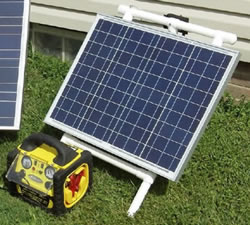 This is a simple and
easy to build solar PV system that will provide some emergency
power during power outages, and can also be used for camping or
for supplying power to a few things around the house on a routine
basis. This is a simple and
easy to build solar PV system that will provide some emergency
power during power outages, and can also be used for camping or
for supplying power to a few things around the house on a routine
basis.
It is very easy to build and a good introduction to solar
projects.
|
Installing Your Own Small,
Remote Off-Grid Solar System,
Jeffrey Yago, Backwoods Home Magazine, Mar 2009
www.backwoodshome.com/articles2/yago116.html
|
 Jeff describes how
to go about designing and installing a small, 12 VDC solar electric
system for a cabin. Jeff describes how
to go about designing and installing a small, 12 VDC solar electric
system for a cabin. |
Solar Power Trailer, Jeffery
Yago
Backwoods Home Magazine, Nov/Dec 2007
www.backwoodshome.com/articles2/yago108.html
|
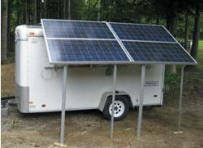 Interesting article by Jeff
Yago on putting together self sufficient trailer mounted PV rig. It
can be used for camping or emergencies. Interesting article by Jeff
Yago on putting together self sufficient trailer mounted PV rig. It
can be used for camping or emergencies.
Part 1 of 2 in the Nov/Dec 2007 issue of Backwoods
Home Magazine -- all issues can be viewed online.
|
| A 320 Watt Truck
Mounted PV System
Full construction details...
|
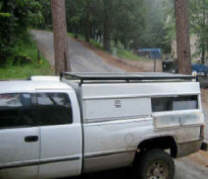 This is a really nice system that fits into a pickup
truck. The 320 watts of PV fit on the existing roof rack, and the
400 amp-hours of batteries in the side compartments. A pair of This is a really nice system that fits into a pickup
truck. The 320 watts of PV fit on the existing roof rack, and the
400 amp-hours of batteries in the side compartments. A pair of Morningstar charge controllers complete the system.
Morningstar charge controllers complete the system.
Great system for camping, tradesmen, RVs, power outage emergencies,
...
Full details on the construction and
wiring... |
Walden Pond -- The Solar Version,
Jeffrey Yago
Backwoods Home Magazine
Part i:
www.backwoodshome.com/articles2/yago99.html
Part II:
www.backwoodshome.com/articles2/yago100.html
Issue 102 article on solar fridges:
www.backwoodshome.com/articles2/yago102.html
|
 Good basic article on setting up a small cabin so it
can be powered by a small PV system. Good basic article on setting up a small cabin so it
can be powered by a small PV system.
Mostly about minimizing electric loads so that the PV system does
not end up costing more than the cabin.
Backwoods Home Magazine issues 99 and 100.
The issue 102 article is a rundown on efficient solar fridges that
run off simple PV systems.
|
| Ron's
Small, Inexpensive Standalone PV System
http://epweb.angelfire.com/solar-pv-system.html
|
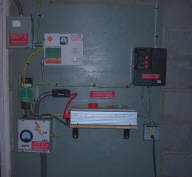 This is another example of putting
together a small, standalone PV system on a shoestring. This is another example of putting
together a small, standalone PV system on a shoestring.
Ron's system makes use of inexpensive used PV panels, a kit
charge controller, and low priced sine wave inverter to build a
300 watt system that he uses to power some loads that are
independent of the grid, and also to provide some backup when the
grid power goes out. Its also a great way to learn about solar
electricity without spending a lot of money.
|
Small and Simple in the North
Woods
Joan R. Surber and Roberta L. Corrigan
How to get articles
from Home Power ...
|
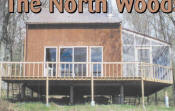 Home Power Magazine article,
issue 75 Home Power Magazine article,
issue 75
Design and implementation of a DC only PV system for a small
cabin. The system has 150W of PV panel, 660AH of battery
capacity, and cost $2500.
|
|
My Solar Casita – solar pumping, Heating,
Cooking, and More!
Samuel Gray
How to get articles from
Home Power ...
|
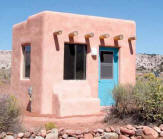 Home Power Magazine article, issue 100 Home Power Magazine article, issue 100
Description of a small off grid PV system with
solar pumping.
700 WH per day demand. 110 Watts of PV panel
total. Good construction detail. A solar passive design adobe
Casita – 120 ft^2.
|
|
Portable Solar-Powered Workshop
Jon Haeme
How to
get articles from Home Power ...
|
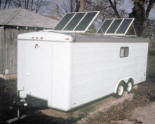 Home Power Magazine article,
issue 47 Home Power Magazine article,
issue 47
Article on a complete, PV powered, workshop in a trailer.
|
|
Backyard Solar Electricity, Made Simple
Mickey Mestel
How to get articles from
Home Power ...
|
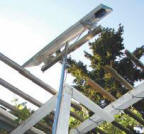 Home Power Magazine article,
issue 93 Home Power Magazine article,
issue 93
Good article on a very small PV system that can be easily removed
and taken along to a new house. 32 W PV panel, 64 AH of battery
capacity in a box, and a 1700 W inverter make up the system. The
total cost is $1350.
|
|
A Small, Portable PV System for Camping, Emergencies, ...
Details on the portable PV
system...
|
 Kevin built a small, portable PV
system to provide some power for lights, radio, cell phone
charging,... on camping trips. Kevin built a small, portable PV
system to provide some power for lights, radio, cell phone
charging,... on camping trips.
The system is small, simple, inexpensive, and easy to build -- a
great learning system.
|
|
Office-Sized Solar-Electric System for Renters
Eric Grisen
How to get articles from
Home Power ...
|
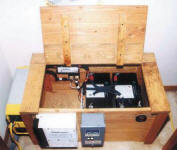 Home Power Magazine article,
issue 96 Home Power Magazine article,
issue 96
Interesting article on a “moveable” 300 W PV system with
batteries. Most of this system fits in and on a wood box. Covers
load analysis, component selection, and building and installing
the system. Cost $4K.
|
|
90 Solar Powered Portable Workshop
How to
get articles from Home Power ...
|
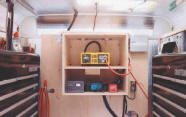 Home Power Magazine article,
issue 90 Home Power Magazine article,
issue 90
Interesting article on a portable, PV powered
workshop in a trailer. Uses one 120W PV panel, 2 Trojan T105
batteries, and an 1800 watt inverter to power a wide variety of
tools. System cost $2600.
|
| PV Systems On RVs
http://www.marxrv.com/12volt/12volt.htm
|
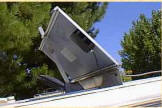 A good write-up on designing,
installing, and maintaining a PV system for an RV. Lots of emphasis
on choosing and maintaining the batteries. A good write-up on designing,
installing, and maintaining a PV system for an RV. Lots of emphasis
on choosing and maintaining the batteries.
While its RV oriented, most of the information is applicable to and
small PV system.
Note that the PV material is in Part 2 of the article.
thanks to Mark for suggesting this) |
Using Your Golf Cart or
Electric Tractor as Emergency Backup Power -- With your Grid-Tied PV
Array for Charging
Details on the ElecTrak
Project...
Details on Using the
ElecTrack (or Golf Cart) with Your Grid-Tied PV Array for Power
Outage Backup... |
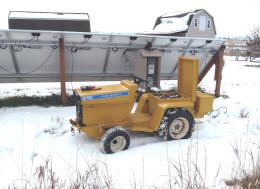 This is our scheme
for providing power during outages. A few of the panels on our
grid-tie PV array are rewired (much easier than it sounds) to charge
the batteries on our ElecTrak tractor (which could be a golf cart or
similar). This is our scheme
for providing power during outages. A few of the panels on our
grid-tie PV array are rewired (much easier than it sounds) to charge
the batteries on our ElecTrak tractor (which could be a golf cart or
similar).
A inverter/charger is used to power key house loads via extension
cords from the ElecTrak.
The nice thing about this scheme is that it cheap to do and it does
not require maintaining a set of batteries that only get used for
power outages. |
| Off
Grid PV Systems -- Homes powered by these systems are not
connected to the utility grid at all. The systems have PV panels
for generation of power, and batteries to store power for when the
sun is not shining. In some cases fossil fuel powered generators
are used to supplement the solar power. As you can see from the
examples below, these systems can range greatly in size, complexity
and price. |
|
Off the Grid Starting Small
Daniel Bisbee
How to get articles from
Home Power ...
|
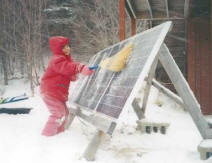 Home Power Magazine article, issue 92 Home Power Magazine article, issue 92
Good article about an off grid house PV system that started very
small and grew to a modest 240 W of PV panels, 660AH or battery
capacity, and a 1500 W inverter that meets all their needs. The
system cost $3K and avoided a $37K charge from the utility company
to extend the power grid. Maybe you really don't need to use
30KWH per day?
|
| RE Earthship Design:
on-the-job-training
Linda Brotman-Evans & Jeff Evans
HP article on Earthship PV (230K pdf)
|
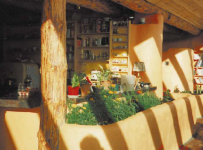 A good Home Power magazine
article on sizing and living with an off grid PV and wind system for
an Earthship. A good Home Power magazine
article on sizing and living with an off grid PV and wind system for
an Earthship.
Good material for planning how to live on a relatively small PV
system -- 1997. |
|
A Simple Solar Solution,
Laurie Guevara-Stone
Mother Earth News
Finding
Mother Earth News articles...
|
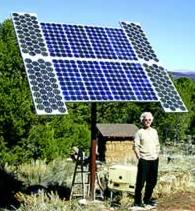 Mother Earth
News Article, Issue 199 Mother Earth
News Article, Issue 199
Good article on planning, building and living with a solar PV
system in an off grid house in Colorado.
|
|
HP99 Solar Comfort in the Idaho Wilderness
Ed Marue
How to
get articles from Home Power ...
|
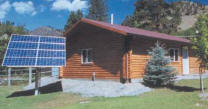 Home Power Magazine article, issue 99 Home Power Magazine article, issue 99
Good article on an off grid system for a mountain cabin. The
system has 960 W of PV panel, 530AH of battery storage, and a 7KW
backup generator, all at a cost of $15K. The owner of the system
covers planning, designing, and installing the system in good
detail.
|
|
Taking the Off-Grid Plunge
Dane Wigington
How to
get articles from Home Power ...
|
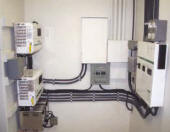 Home Power Magazine article,
issue 98 Home Power Magazine article,
issue 98
Article describes a large, off-grid system capable of supporting
large electrical loads. 5.1KW of PV panels and 2400 AH of battery
capacity. Supplemented with two wind generators.
|
|
Off Shore and Off Grid – Island Life Unplugged
John McNicholas
How to
get articles from Home Power ...
|
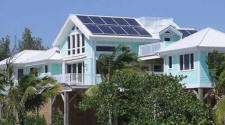 Home Power Magazine article, issue 106 Home Power Magazine article, issue 106
Good detailed description of a large, off grid PV system for a
Florida island house with large loads. 3600 W PV panels, 2500 AH
battery system, 20KW generator. $61K worth of components.
|
The Care and Feeding of Solar Batteries,
Jeffrey Yago, Backwoods Home Magazine, Sep 2005 |
 An article by Jeff Yago on batteries
for off-grid solar electric systems. An article by Jeff Yago on batteries
for off-grid solar electric systems.
The article covers battery types, and goes into caring for and
maintaining batteries for a long life.
Batteries are a high ongoing cost for off-grid solar and its very
easy to kill an expensive battery set before its time, so this is
good stuff to know. |
| Grid
Tie PV Systems Without Battery Backup -- Homes on these
"grid-tied" systems are connected to the utility grid. When the PV
panels are producing more electricity than is being used in the
house, the meter runs "backwards", and the excess power goes into
the utility grid. These systems do not have batteries for storage
of electricity. When the utility power fails, the lights go out in
these houses, even if the sun is shining. But, the significant cost
and maintenance issues owning batteries are avoided. |
| Designing and
Installing Your Own Grid-Tied PV System
Much detail on our system...
Major
Update of system 2019...
Upgrade
System To Add an EV...
The two year report...
|
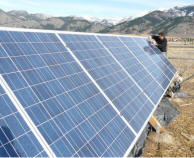 This
is a very detailed account of planning, designing and installing
our own new 2150 watt grid-tied PV system. This
is a very detailed account of planning, designing and installing
our own new 2150 watt grid-tied PV system.
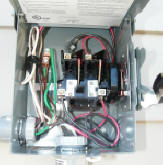
A lot of detail is provided on the full process, including
deciding on type of system, how big to make it, where to put the
panels, solar site survey, what kind of mounts to use, building
the mounts, installing the components, doing the wiring, and the
performance and economics of the system.
The system uses the same Enphase micro-inverter scheme as Guy's
system (just below), so between these two entries there should be
enough detail to keep you busy for quite a while!
We did a major
upgrade of the system in 2019 that more than doubles the size of
the system and upgrades to the latest Enphase technolgogy...
|
|
Our Elec-Trak Tractor Project
-- Using an Elec-Trak to Power Your House in Power Outages
-- Charging the Elec-Trak from a Grid-Tie PV System just above
(this is one way to get around grid-tie
systems going down in power outages -- and have a good way to
mow your lawn to boot :)
All the details...
|
 This is a very detailed account of
our project to recondition an Elec-Trak electric tractor. All the
fascinating This is a very detailed account of
our project to recondition an Elec-Trak electric tractor. All the
fascinating details on scraping and painting,
... details on scraping and painting,
...
It also covers using the Elec-Trak battery pack to power the house
in emergencies AND a way to charge the pack from our grid-tied PV
array.
All the details...
|
Doug's New 4.6 KW DIY Grid Tied PV Array
|
 This is a really well done grid-tied PV
project by Doug Kalmer. It is a 4.6 KW array using Enphase micro
inverters. This is a really well done grid-tied PV
project by Doug Kalmer. It is a 4.6 KW array using Enphase micro
inverters.

Doug has worked out a very nice, long life, low cost mounting system
that he shows in detail.
All the details on Doug's
system... |
Installing a
grid-tie solar electric power system,
Guy Marsden
Full, step by step description of the system:
http://www.arttec.net/SolarPower/index.htm
Real time output data:
http://www.arttec.net/SolarPower/9_Stats/index.htm
|
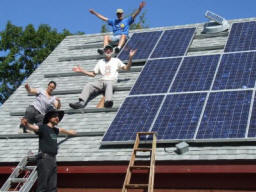 Guy Marsden describes the whole process of selecting,
designing and installing his new grid-tie PV system. Since Guy and
friends did the whole installation, there is a lot of detail. Guy Marsden describes the whole process of selecting,
designing and installing his new grid-tie PV system. Since Guy and
friends did the whole installation, there is a lot of detail.
Guy's system uses the new Enphase micro inverter system in which
each PV panel gets its own inverter. The Enphase system reduces
installation labor, and allows easier future expansion. Guy also
provides
real time system output stats.
Guy has done several fine renewable energy and solar projects, and
has detailed tutorials on each one -- a look through his whole
website is very worthwhile. |
| 6.3 KW DIY grid tied PV system from
Instructables... |
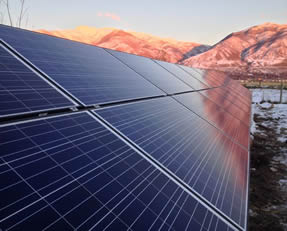 Very good Instructables writeup on a 6.3 KW grid
tied PV array. Very good Instructables writeup on a 6.3 KW grid
tied PV array.
Lots of good detail.
|
|
Solar Energy in WV, do it
yourself
http://solarenergyinwv.blogspot.com/
|
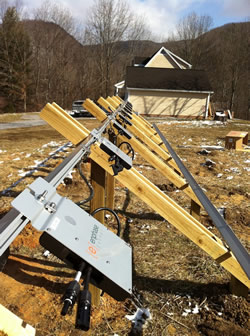 A very nicely done grid tied PV
system using micro inverters in West Virginia. A very nicely done grid tied PV
system using micro inverters in West Virginia.
|
The
tinkeringcaveman Solar Project
https://sites.google.com/site/tinkeringcavemansolarproject/
|
 This
is a very nice and detailed five part blog from Kevin on planning,
permitting, and installing a micro inverter based 3.84KW grid-tie
system. This
is a very nice and detailed five part blog from Kevin on planning,
permitting, and installing a micro inverter based 3.84KW grid-tie
system.

Kevin worked in partnership with a local electrician -- I think this
is a good approach and likely makes for less to learn and a smoother
install. Lots of good detail on the whole process. |
| Mick and Janet's Photovoltaic Solar
System
http://www.users.on.net
|
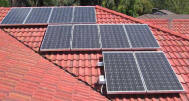 Nice personal website describing a grid
tied PV installation. Provides over a year of performance data.
Pictures of installation with good detail on panel mounting. Nice personal website describing a grid
tied PV installation. Provides over a year of performance data.
Pictures of installation with good detail on panel mounting. |
|
Grid-Tied Soar In Small Town, USA
Article from AndyKerr.net...
How to get articles from
Home Power ...
|
 Good Home Power Article on authors
attempt to be "Carbon neutral" through conservation, less fossil
fuel, solar active and passive strategies, and a grid tied PV
system. Most of the article details his experiences with installing
a grid tied PV system in Ashland, OR -- a pretty positive experience
all-around. Good Home Power Article on authors
attempt to be "Carbon neutral" through conservation, less fossil
fuel, solar active and passive strategies, and a grid tied PV
system. Most of the article details his experiences with installing
a grid tied PV system in Ashland, OR -- a pretty positive experience
all-around. |
|
Getting Off the Lifetime Utility Payment Plan
Daren Webster
How to get articles from
Home Power ...
|
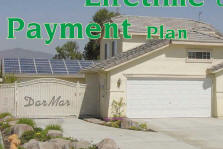 Home Power Magazine article,
issue 95 Home Power Magazine article,
issue 95
Good article on a large, suburban California, grid tied,
batteryless system. Covers load estimation, system design, and
installation (by owner). The $28K system has 4KW of PV panels.
|
Grid-Tie Solar
Powered Farm,
Jefferey Yago,
Backwoods Home Magazine, July/August 2005
The full article ...
|
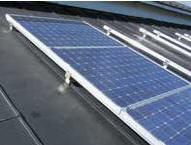 An article in Backwoods Home magazine by
Jeff Yago on a grid tie system with some useful design and install
information. An article in Backwoods Home magazine by
Jeff Yago on a grid tie system with some useful design and install
information.
Note how simple the modern grid-tie inverters make these systems. |
|
Solar Electricity in Spite of the Fog
Greg Bundros
How to get articles from
Home Power ...
|
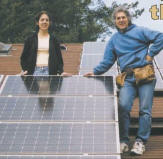 Home Power Magazine article, issue 99 Home Power Magazine article, issue 99
Good article on an grid tied PV system in Northern California.
The system has 1320W of PV panels and cost $22K before rebates.
The author installed the system, and covers design and
installation of the system. He also provides very detailed
performance records for the system.
|
|
Solar Electric Vision Becomes Reality
Alan Stankevitz
How to get articles from
Home Power ...
|
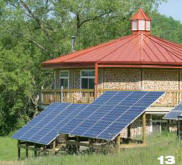 Home Power Magazine article, issue 105 Home Power Magazine article, issue 105
Description of a 4KW grid intertied,
batteryless PV system. A full description of the system is
provided including costs. The system was installed by the owner,
and some of the details of the installation an permitting process
are described.
|
|
From The Ground Up – My RE System Design
Choices
Linda Pinkham
How to
get articles from Home Power ...
|
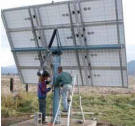 Home Power Magazine article, issue 106 Home Power Magazine article, issue 106
Good article on going through all the decisions to be made in
implementing an medium size, grid tied PV system. Size, siteing
collectors, tracking or not, batteries or not, component
selection, …
|
|
Solar Solidarity – An IBEW-Supported PV System
Vincent Endter
How
to get articles from Home Power ...
|
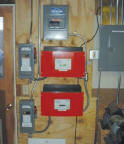 Home Power Magazine article,
issue 97 Home Power Magazine article,
issue 97
Good article on installation of a 5KW, grid-tied, no batteries
system for a residence in California. Quite a bit of detail on
the design and installation of the system.
|
| Illustration of 8
KW (DC) GT Solar PV System Install for Residence in Urban Area
www.wind-sun.com/ForumVB/showthread.php?t=6394
|
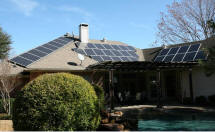 This is a many page post on Northern Arizona Wind
& Sun forum. It covers the installation of an 8.1KW grid-tied
PV system. This is a many page post on Northern Arizona Wind
& Sun forum. It covers the installation of an 8.1KW grid-tied
PV system.
Lots of detail is provided, and there is some good discussion of the
system. |
| Construction Details for a PV Array at
Craters of the Moon Monument |
 Some detailed
pictures of a large PV array at Craters of the Moon National
Monument. The clean mounting system and simple wiring and equipment
mounting might provide some helpful ideas for your system. Some detailed
pictures of a large PV array at Craters of the Moon National
Monument. The clean mounting system and simple wiring and equipment
mounting might provide some helpful ideas for your system.
Construction Details for a PV Array
at Craters of the Moon Monument... |
| Clarian SmartBox
Plug-In the Wall Grid-Tie PV system
My blog entry on the system...
The
Clarian website...
|
 This is an interesting grid-tie, microinverter system
that literally plugs into a wall outlet. This is an interesting grid-tie, microinverter system
that literally plugs into a wall outlet.
It can start with one 200 watt PV panel and be easily expanded with
additional panels.
Prices are projected to be about $4 per watt -- it is supposed to
"be in stores in 2011". |
| Cold Springs
Solar Power
|
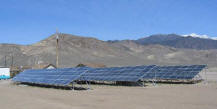 This is a huge solar electric
installation at the Cold Springs Station on Hwy 50 in a very lonely
part of the Nevada desert. It is a 30KW grid tied PV installation
that sells excess power to the utility. This is a huge solar electric
installation at the Cold Springs Station on Hwy 50 in a very lonely
part of the Nevada desert. It is a 30KW grid tied PV installation
that sells excess power to the utility.
Some nice construction details in the
photos. |
|
A grid tied inverter that provides emergency power
during outages..
|
With most grid-tied systems, when the grid goes down, the
grid-tie PV system also goes down, and you get no power even if
the sun is shining.
This new grid-tie inverter from SunnyBoy provides about 1500
watts of back up power when the grid is down and the sun is out.
It does not require batteries to do this -- a major plus.
The article Alex Wilson article from the Green Budilding
Advisor site provides quite a bit of detail on it...
|
|
Grid Tie PV System Kits -- The
systems listed just below are the first offerings of PV systems
that are aimed at homeowner installation. They are small (but
expandable), grid-tied systems that are relatively easy to
install. They all use microinverters (one per PV panel) to
simplify the systems and to allow one to start small, but easily
expand.
NOTE: It appears that all three of the pv system kits
listed below have been dropped. I would
not let this discourage you from doing your own system, as some of
the systems are relatively straight forward to put in as a diy
project as long as you are willing to invest some learning time. I
would look over the first two systems described in the "Grid Tied
PV" section on this page -- they provide quite a bit of detail and
should allow you to make a decision about whether you want to
tackle installing a system yourself. Another option is to do most
of the install yourself and get some help on the parts you don't
want to tackle.
Also, the "Power to the people..." project
listed below makes a great way to get started.
|
|
Westinghouse DIY Solar Kit
Westinghouse
Solar...
Do It Yourself Resources...
Installation Manual... (pdf)
Kit Contents...
All the above links are dead -- it looks like Westinghouse has
dropped the diy kit PV systems.
|
 Westinghouse announced the release of
solar PV kits for DIY installation. The kit includes the PV
modules, microinverters, parts for roof mounting, and the other bits
needed to complete the system. Westinghouse announced the release of
solar PV kits for DIY installation. The kit includes the PV
modules, microinverters, parts for roof mounting, and the other bits
needed to complete the system.
It appears that each PV module mounts to the roof independently, and
that the mounting hardware is included. It appears that the
microinverters are integrated with the PV panel. The kits will be
offered in 3 sizes: 1 panel, 4 panels, and 20 panels, where each
panel is 235 watts. As with all microinverter based systems, it is
easy to expand the sytem.
The Westinghouse Solar website links to the left give more
information on the system. There are some resources for DIYers, and
what looks to be a detailed and well written installation guide.
Westinghouse appears to be pretty serious about this effort.
The Westinghouse sales person told me that the systems can be
ordered via Lowes Hardware, and the the cost for a 4 panel (940
watt) system is about $2600. This does not include the Enphase EMU
monitoring unit, which many people will want to monitor the system.
The system is based on the Enphase microinverter -- you can get a
detailed understanding of how this system works and goes together by
reading the first two entries in the Grid
Tied PV section ...
I would love to hear from anyone who gives this system a try. |
Clarian SmartBox
www.clarianpower.com (Not working -- Clarian appears to have
gone out of business?)
|
 This is a similar microinverter based
DIY PV system kit from Clarian. It was announced some time back,
but is not yet available for sale -- hopefully soon. This is a similar microinverter based
DIY PV system kit from Clarian. It was announced some time back,
but is not yet available for sale -- hopefully soon.
This BuildItSolar Blog entry and the Clarian Website give as good a description as
I could work out from the limited material available.
|
Starter Kits based on the Enphase Micro
Inveter.
Some example suppliers:
http://www.greenpowersystems.net/...
http://www.wholesalesolar.com/...
http://www.solarmade.com/...
There are likely many more, and any solar retailer who handles the
microinverter systems can put together a similar kit for you. |
 These are starter kits that several of
the PV retail suppliers have been offering based on the Enphase
microinverter. These systems typically consist of one PV panel, one
Enphase microinveter, and possibly a rack and some other odds and
end. These are starter kits that several of
the PV retail suppliers have been offering based on the Enphase
microinverter. These systems typically consist of one PV panel, one
Enphase microinveter, and possibly a rack and some other odds and
end.
The systems are basically one panel versions of
my system, and you can get an idea how the work and how they
go together by reading the details on my system and just reducing
the number of panels from 10 to 1.
Calling these systems kits is a bit of a stretch in that they are
not likely to come with a start to finish step by step manual -- you
will get a pile of parts, and its up to you to work out how they go
together. This can be and interesting challenge or a nightmare
depending on what you were expecting.
The kits vary a great deal in how complete they are. The things
that may or may not be included are: a rack or mounting hardware,
the Envoy monitoring unit, connecting wire and breakers.
These systems are not toys and they are not dead ends -- they are
fully functional (if small) PV systems, and they can be expanded
seamlessly up to multi kilowatt systems as your budget allows. I
think they are a good way to go if you want to start small and learn
a lot.
Be aware that even on these small systems, you will be working on
240 VAC house power circuits -- so, do your safety homework. |
|
Power to the People: How to Build a Plug and
Play Grid Tie Solar Array, from the Ken-nect
Blog
All the details on this under the radar PV
scheme..
|
  This is a way to do a small, under the radar,
grid-tied PV system that uses a China import grid-tie inverter. This is a way to do a small, under the radar,
grid-tied PV system that uses a China import grid-tie inverter.
This could make for a cheap system -- some PV modules are available
for about $1 per watt, and the inverter can be found on ebay for
about $0.35 a watt --add a bit for mounts, wire, etc. and you would
likely still be under $2 per watt.
The utility is not going to approve this as a grid-tie system for
net metering, but if its kept small, net metering is not really a
factor as your usage will nearly always be more than the system is
producing. While the inverter includes anti-islanding, it is not UL
approved for grid-tie use. |
| Grid
Tie PV Systems With Battery Backup -- These homes are
connected to the utility grid, and work in the same way as the
"grid-tied" homes above, but they also have batteries, which allows
the lights to stay on when the utility power goes down. On the
negative side, the systems are more expensive, and the batteries
must be carefully maintained. |
| Note that new inverters that are
designed specifically for grid-tied with battery backup systems have
recently come out -- these include:
Outback
GVFX series
Xantrex XW series
|
|
| Bob's Solar Project
http://www-personal.umich.edu/%7Ebgoodsel/solar/blog.htm
|
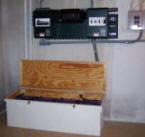
This is Bob's blog on installing a grid tied with batteries,
Unisolar PV shingle system. It is very detailed and should be
very helpful to anyone considering doing this.
All the details on the design, solar shingle installation, wiring,
and equipment installation are covered in detail. Thank you Bob!
|
| Grid Tied PV
and Wind System with Battery Backup
http://www.rockriver.us
|
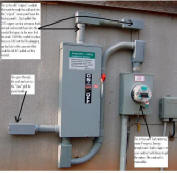 A very good personal website on designing
and installing a PV and wind system that is grid tied with battery
backup. A very good personal website on designing
and installing a PV and wind system that is grid tied with battery
backup.
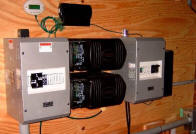
Lots of detail and helpful information on design, components,
installing, wiring, suppliers, permitting, ...
|
|
Grid Tie, Battery Backup, and System Monitoring
Brent Simons
How to get articles from
Home Power ...
|
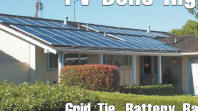 Home Power Article, issue 94 Home Power Article, issue 94
Very good article on planning, designing and installing a 4.8KW
grid-tied PV system with 400AH battery backup, and a 4KW
inverter. The system also includes instrumentation to monitor the
performance of the system. Quite a bit of component and
installation detail.
|
| PV
Tracking and Mounts and Soft Concentrators -- Systems that
track the sun or that use reflective surfaces to concentrate more
light on the PV cells make better use of the expensive PV cell
material. |
An HP Article on PV Tracker Basics,
Richard Perez
www.zomeworks.com/...
|
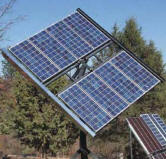 An article explaining the
basics of PV tracking. Contrasts the passive trackers with the
electronic trackers. An article explaining the
basics of PV tracking. Contrasts the passive trackers with the
electronic trackers. |
Field Test Results of the Archimedes
Photovoltaic V=Trough Concentrator System,
Klotz, Mohring, Gruel, Sherborne, Bruton, Albella, and Tzanetakis
Archimedes Paper (pdf)
|
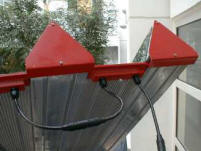 Very good paper with results
on testing a simple scheme that uses one axis tracking coupled with
high acceptance angle V troughs to provide average daily
concentrations around of around 2. Simple aluminum cooling fins
are used to keep cell temperature comparable to non-concentrating
commercial PV panels. Very good paper with results
on testing a simple scheme that uses one axis tracking coupled with
high acceptance angle V troughs to provide average daily
concentrations around of around 2. Simple aluminum cooling fins
are used to keep cell temperature comparable to non-concentrating
commercial PV panels.
(My thanks to Greg for suggesting this) |
| Low Cost Tracking Ridge Concentrator
http://www.pvpumps.com/
Picture Gallery of Examples:
http://www.solar-trackers.com/photogalery
|
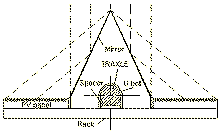 Simple tracker and
concentrator design might nearly double PV panel output. Simple tracker and
concentrator design might nearly double PV panel output.
The website(s) are a bit confusing, but provide some useful
material.
I'd like hear from anyone who has had experience with these.
|
Pumping Water for Irrigation Using Solar
Energy
H.J. Helikson, D.Z. Haman and C.D. Baird
University of Florida -- Extension Service
Pumping Paper
(pdf)
|
 Interesting 1992 paper on PV powered
pumping for irrigation wire. Good analysis of system. Interesting 1992 paper on PV powered
pumping for irrigation wire. Good analysis of system.
Interesting reflector/tracking arrangement on the PV panels that
increases panel output significantly.
|
| RedRok.com LED3Xc3
Solar Tracker Assembly
http://www.redrok.com/led3xassm.htm#led3xforsale
|
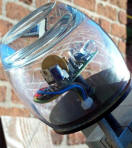 Duane at RedRok.com offers a
$35 tracker that can drive a simple satellite dish linear screw
actuator to make an inexpensive tracker for PV and other
applications. Duane at RedRok.com offers a
$35 tracker that can drive a simple satellite dish linear screw
actuator to make an inexpensive tracker for PV and other
applications.
The page gives examples of many systems using the RedRok tracker.
|
| $35
DIY PV Tracker |
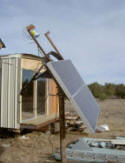 This home made
tracker for PV panels is made from a satellite dish antenna and the
RedRok.com $35 tracker, plus an old bed frame! This home made
tracker for PV panels is made from a satellite dish antenna and the
RedRok.com $35 tracker, plus an old bed frame!
|
Mother's Super-Simple Solar Tracker
Dennis Burkholder
Finding Mother
Earth News articles...
|
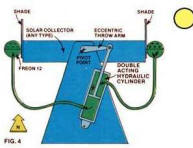 Mother Earth News Article,
Issue 48, Nov/Dec 1977. Mother Earth News Article,
Issue 48, Nov/Dec 1977.
This article provides some how-to information on designing and
building solar array trackers that use canisters of refrigerant to
passively track the sun. This is similar to the very popular
ZomeWorks trackers. Several designs are discussed.
The trackers in the article use Freon -- in a new design you would,
of course, have to substitute a different refrigerant. |
| Canuckle Tracker
http://www.greenwatts.info/
|
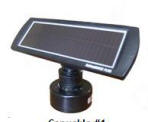 Light duty solar trackers that you can
make from computer parts and ABS tubing. Light duty solar trackers that you can
make from computer parts and ABS tubing.
And, a simple Sun Switch sun sensor and motor driver.
|
Water-Powered PV Tracker
Bill Spurlock
How to get articles from
Home Power ...
|
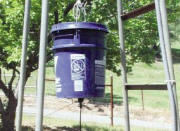 Home Power magazine article,
issue 85 Home Power magazine article,
issue 85
An interesting mix of high tech PV and low tech genius to
implement a water powered PV array tracking system.
|
| PV
Array Mounts |
| A simple
mount using treated wood plus commercial rails...
|
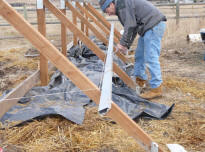 This is the simple set of
mounts I used for my PV array. It uses commercially available rails
to mount the PV panels to along with simple treated wood timbers and
concrete footings. This is the simple set of
mounts I used for my PV array. It uses commercially available rails
to mount the PV panels to along with simple treated wood timbers and
concrete footings. |
Doug's New 4.6 KW DIY Grid Tied PV Array
Doug came up with a very durable and inexpensive mounting system
that saved many hundreds of dollars over commercial mounts. |
 This is a really well done grid-tied PV
project by Doug Kalmer. It is a 4.6 KW array using Enphase micro
inverters. This is a really well done grid-tied PV
project by Doug Kalmer. It is a 4.6 KW array using Enphase micro
inverters.

Doug has worked out a very nice, long life, low cost mounting system
that he shows in detail.
All the details on Doug's
system... |
|
Simplified Building Concepts Pipe Racks
|
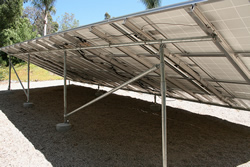 Simplified Building Concepts offers
several systems that use standard galvanized metal pipe with
fittings that allow the pipe to be configured for just about
anything, including PV panel mount racks. Looks like a very
flexible and easy to use system, and people report that they are
willing to help you make your project work. Simplified Building Concepts offers
several systems that use standard galvanized metal pipe with
fittings that allow the pipe to be configured for just about
anything, including PV panel mount racks. Looks like a very
flexible and easy to use system, and people report that they are
willing to help you make your project work.
They have several PV racks in their projects gallery -- here is one nice one...
|
| Another
way of doing treated wood supports with commercial rails...
|
 This is a nice and simple system that
uses a combination of commercially available aluminum rails attached
to large treated timbers that anchor the front and back of the PV
array. This is a nice and simple system that
uses a combination of commercially available aluminum rails attached
to large treated timbers that anchor the front and back of the PV
array. |
| Construction Details for a PV Array at
Craters of the Moon Monument |
 Some detailed pictures of a PV array
mount system using galvanized steel pipes coupled with standard
industrial fittings to make a sturdy, simple and clean looking mount
system. Some detailed pictures of a PV array
mount system using galvanized steel pipes coupled with standard
industrial fittings to make a sturdy, simple and clean looking mount
system.
Mount Details for a PV Array at
Craters of the Moon Monument... |
| Home Built Solar Mount
http://altenergy.blog-city.com/mount.htm
My home built PV mount...
|
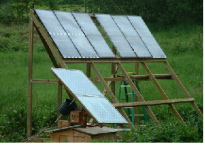 Pretty good looking and well
anchored wood mount for PV panels. Pretty good looking and well
anchored wood mount for PV panels. |
|
Installing PV Systems -- How-To
|
Some of the articles above that describe
example PV systems have some construction detail, so see these as
well.
PV systems have become more straightforward to install as equipment
has been refined over the years -- grid-tie systems in particular
have become much simpler. But, this does not mean its an easy DIY
project. There are serious safety issues that you must fully
understand -- even folks with considerable AC system wiring
experience should be very careful to learn and understand the
hazards of working with strings of PV panels that will produce
several hundred volts whenever the sun is on them.
In addition to the safety issues, there are permits and utility
companies to deal with -- some areas may not even allow a home owner
to install his/her own system. So, as always, do your homework! |
| See the entries in the other sections on
"Off Grid", "Grid Tied", etc. These articles contain lots of
detailed accounts of DIY installations. |
|
Solar System
Install Guide
The full tutorial:
http://www.pasolar.ncat.org/lesson01.php
The PV part starts in Lesson 5:
http://www.pasolar.ncat.org/lesson05.php
|
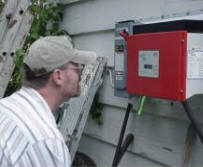 This is a pretty good and detailed
installation tutorial for installers. This is a pretty good and detailed
installation tutorial for installers.
Its about the most readable thing I have found that provides enough
detail to be useful in installing your own system. |
Photovoltaic Power Systems and the 2005
National Electrical Code: Suggested Practices
John Wiles, Southwest Technology Development Institute, New Mexico
State University
www.nmsu.edu/~tdi/PV=NEC_HTML/pv-nec/pv-nec.html
Suggested Practices for PV System Wiring 2005 ... (pdf)
|
 A set of quite detailed
suggested practices for wiring PV systems to comply with the
National Electric Code. A set of quite detailed
suggested practices for wiring PV systems to comply with the
National Electric Code.
Kind of tough sledding if you are not a code devotee, but accurate
and authoritative. |
Inspector
Guidelines for PV Systems,
Prepared by Brooks Engineering for PACE University
Inspector
Guidelines for PV Systems (pdf)
Inspecting Photovoltaic (PV) Systems for Cod Compliance...
|
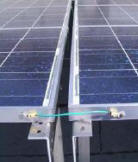 This is a very helpful set
of guidelines on PV system equipment, and particularly on wiring of
PV systems. This is a very helpful set
of guidelines on PV system equipment, and particularly on wiring of
PV systems.
I found it helpful in both the planning of the details of the
component locations and the wiring, and as a good checklist on what
inspectors will be looking for.
The second link is 168 page presentation with lots of examples and
photos. Probably more detailed than most will need, but lots of
examples of common mistakes. |
| NABCEB (North American
Board of Certified Energy Practitioners)
NABCEB
...
NABCEB Resources...
|
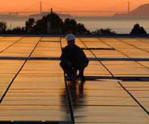 The NABCEB offers certifications for
installers of PV systems. The NABCEB offers certifications for
installers of PV systems.
Their web site Resources page has much information of interest to
people want to install a system or want to be knowledgeable about
what a good installation should look like.
The "Study Guide for Photovoltaic System Installers" is a good one.
(thanks to Doug for suggesting this) |
A Guide to Photovoltaic (PV) System
Design and Installation,
California Energy Commission, June 2001
www.energy.ca.gov/reports/2001-09-04_500-01-020.PDF
|
 A pretty detailed guide written for
installers of PV systems in California. largely applicable to other
areas. A pretty detailed guide written for
installers of PV systems in California. largely applicable to other
areas. |
Residential/Commercial Solar PV Installations,
Basic information and installation guides for roof mounted systems,
Ed Larsen, June 2008
City of Flagstaff/Project Review Section
Residential/Commercial Solar PV Installations ...
(PowerPoint)
|
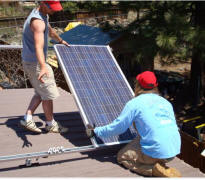 A Power Point set of
guidelines for roof mounted PV installations. A Power Point set of
guidelines for roof mounted PV installations.
Some good planning, design, and installation detail. Quite a bit of
detail on installation.
Written for Flagstaff, but generally applicable. |
| How to Install A
Pole-Mounted Solar-Electric Array
How to get articles from
Home Power ...
|
 Home Power magazine two part article in
issues 108 and 109 on installing a pole mounted PV array. Home Power magazine two part article in
issues 108 and 109 on installing a pole mounted PV array.
A very detailed how-to -- lots of good advice.
|
PV Combiner Box Buyers Guide,
Lena Wilensky
How to get articles from
Home Power ...
This article covers a lot of the issues of wiring
the array to the inverter.
|
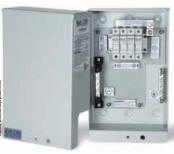 Home Power Magazine article, issue 132, Aug-Sept
2009. Home Power Magazine article, issue 132, Aug-Sept
2009.
Good article, not only goes over available combiner box
offerings, but covers the wiring, fusing, and sizing procedures
for the boxes.
Also tells you when you don't need one at all.
|
| Picking the right
wire size
|
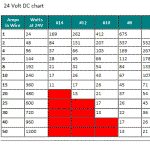 PV
oriented wire voltage DC drop table... PV
oriented wire voltage DC drop table...
General purpose wire voltage drop calculator...
More refs on
wire sizing...
|
|
Maverick Solar DIY Workshop
http://www.mavericksolar.net/
|
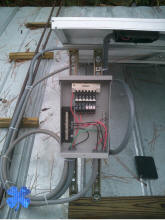 A collection of helpful articles and
references for DIYers on PV systems. A collection of helpful articles and
references for DIYers on PV systems.
Includes some fairly detialed examples of several systems, and
some good "how-to"s on wiring etc.
|
| PV
Components |
| See also the list of
suppliers for PV systems ...
|
|
|
Renewable Energy Design Guide and Catalog --
34th edition
Sign up to download the free 268 page guide/catalog
here...
|
 This is a very helpful reference and
catalog for renewable energy systems. It covers PV, wind and small
hydro with emphasis on PV. This is a very helpful reference and
catalog for renewable energy systems. It covers PV, wind and small
hydro with emphasis on PV.
Right up to date and with lots of information on PV system
components and lots of good reference material.
|
PV Combiner
Box Buyers Guide,
Lena Wilensky
How to get articles from
Home Power ...
|
 Home Power Magazine article, issue 132, Aug-Sept
2009. Home Power Magazine article, issue 132, Aug-Sept
2009.
Good article, not only goes over available combiner box
offerings, but covers the wiring, fusing, and sizing procedures
for the boxes.
Also tells you when you don't need one at all.
|
|
106 What’s Going On – The Grid? A New
Generation of Grid-Tied PV Inverters
Joe Schwartz
How to get articles from
Home Power ...
|
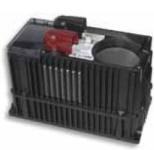 Home Power Magazine article, issue 106 Home Power Magazine article, issue 106
Rundown on the latest in inverters for grid tied PV systems.
What to look for, and how they rate.
|
| Deep Cycle
Battery FAQ
www.windsun.com/Batteries/Battery_FAQ.htm
|
 This is a good rundown on the type of batteries
normally used in PV systems. This is a good rundown on the type of batteries
normally used in PV systems.
Lots of good information.
|
| PV
Shade Structures -- various ways to use PV modules as an
integral part of solar shading structures |
Solar Deck Canopy -- How Well Does It Let Light
Through During Winter?
Amy Heidner, PE, 2012 |
 This is a very
interesting paper showing the use of PV panels as part of a shade
canopy that provides shade for living space that was overheating and
generates solar electricity as well. This is a very
interesting paper showing the use of PV panels as part of a shade
canopy that provides shade for living space that was overheating and
generates solar electricity as well.
The aim of the project was to provide sufficient shading to keep the
living area behind the canopy from overheating, while at the same
time not providing so much shade that the the deck and living area
would be too dark.
The authors found that by selecting a PV module design that lets
some light through and adding some glazed areas above and below the
PV modules that they could get just the right light levels under the
canopy.
|
Bifacial PV
Modules for Sun Shade Structures
Solarscapes - a New Face for PV,
Topher Donahue
Originally appeared in HomePower Magazine
PV shade structures utilizing bi-facial PV modules
Another example
Sun & Shade with a 9.12 KW PV Awning System,
Justine Sanches with Greg Koss,
HomePower Magazine, Feb 2009 |
 This
article describes the use of bifacial PV modules for building sun
shade structures that let a controlled amount of light to penetrate
the shaded area and simultanously harvest solar electricity. This
article describes the use of bifacial PV modules for building sun
shade structures that let a controlled amount of light to penetrate
the shaded area and simultanously harvest solar electricity.
Bifacial PV modules convert light coming in to either side of the PV
module into electricity. In contrast to monofacial PV modules they
do not have an opaque layer beneath the silicone cells -- they are
semi-transparent to sunlight. This can make them ideal for shading
structures that want to pass more light into the shaded area that
regular opague modules would.
The article provides an overview of using these panels to design
sunspaces, and gives a few nice residential examples. |
Solar Canopies...
From
www.floriansolarproducts.com |
 A
nice collection of solar shade canopy exmaples. A
nice collection of solar shade canopy exmaples. |
A Solar Pergola...
|
 Brief description
of a nice pergola constructed with PV panels over a wood pergola
framework. Brief description
of a nice pergola constructed with PV panels over a wood pergola
framework. |
| A
few more PV module shading structure pictures... |
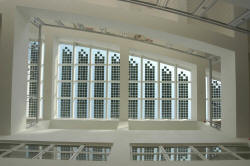 These are just a
few more random pictures of shading
structures made from PV modules... These are just a
few more random pictures of shading
structures made from PV modules... |
| Off
Grid Cooling |
| Cooling for off-grid homes can be
difficult due to the need to minimize electrical power use. This
section has a couple of low electricity use cooling schemes.
A whole house fan that operates on DC would be another good one,
but I have not seen one.
Many of the passive techniques listed in the Cooling
Section apply VERY well to PV powered homes since they use
no power at all.
|
| Ceiling fans with aerodynamically
designed blades
http://www.fanworks.com/vari-cyclone.htm
|
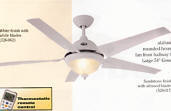 Ceiling fans with "Gossamer Wind"
technology blades move about 40% more air for the same power use. Ceiling fans with "Gossamer Wind"
technology blades move about 40% more air for the same power use.
Models are available that operate at 12 or 24V, and can be operated
direct PV or battery.
FSEC paper:
Performance and Applications of Gossamer Wind™ Solar Powered
Ceiling Fans |
| PV Powered Evaporative Coolers
www.nvo.com/southwestsolar/productcatalog/
Some notes on a DIY one:
www.voltscommissar.net/competitive_edge.htm
|
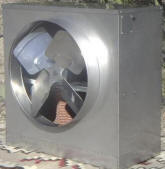 These evaporative coolers
use low HP 12V fans that can be powered by PV arrays. These evaporative coolers
use low HP 12V fans that can be powered by PV arrays. |
| Off
Grid Refrigeration |
Refrigeration is one of the
major electric loads for an off grid home.
Some of the solutions people are using:
- Use a modest size Energy Star rated conventional
refrigerator. This approach has a low initial cost, and pretty
good energy efficiency. See the Energy Star link below for for
the best ones.
Conventional freezer above and fridge below are the most energy
efficient and make best use of space.
- Use one of the brands that specialize in high efficiency
fridges for PV use, such as SunFrost or SunDazer. Less energy
use, but higher initial cost.
- Also listed below are some less conventional solutions that
use even less power, and are inexpensive.
- Another option is a propane powered fridges. These are very
energy inefficient fridges, and (I think) are best avoided --
but some like them a lot.
(as near as I can tell looking at energy stats
from sellers, propane fridges use about 5 times more energy
than energy star electrics of the same size)
|
| Energy Star
Energy
Star Ratings ...
|
 Energy ratings
and energy use for appliances. Energy advice and online audit for
homes. Energy star appliances and homes. Energy ratings
and energy use for appliances. Energy advice and online audit for
homes. Energy star appliances and homes.
In my view, the Energy Star program could be more aggressive, but
its certainly a good place to start. For example, they have no
plans to require more efficient refrigerators until 2012 at the
earliest -- let them know you would like to see a more aggressive
approach. |
| Efficient Refrigerators for
PV
SunFrost
http://www.sunfrost.com/refrigerators_main.html
SunDanzer
http://www.sundanzer.com/
|
A couple of brands that specialize in
low power consumption fridges and freezers for PV. 
SunFrost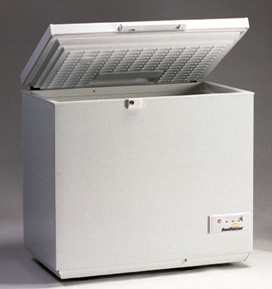 SunDanzer SunDanzer
|
| Very Efficient Chest
Refrigerator
Chest
Fridge Full Article (68K pdf)
This article is from the Mt Best -- Australia solar house site: http://mtbest.net/
A very interesting solar house with several unique features, and a
bit more info on the chest fridge.
Another approach here... (if this link does not
work, try it here on the Wayback Machine...)
Uses added thermal mass and a simple timer switch -- the thermal
mass is intended to allow the fridge and inverter on an off grid
site to be turned off overnight to save the idle inverter load on
the batteries.
The thermostat shown on this page is reported to allow you to use
a chest freezer as a refrigerator with large energy saving:
Beer Fridge Thermostat
|
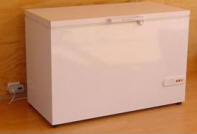 This
refrigerator, which is a converted chest type freezer uses only
about 0.1 KWH per day. See the article for details. Latest update
includes a design for a low standby power thermostat. This
refrigerator, which is a converted chest type freezer uses only
about 0.1 KWH per day. See the article for details. Latest update
includes a design for a low standby power thermostat.
Apparently not all chest freezers are created equal, as some do not
report quite as dramatic an energy saving as Tom reported in his
paper -- so if you are getting a new chest freezer for this, pick an
efficient one to start with.
One person reported 0.3 KWH per day (108KWH/year) on a newer Kenmore
freezer that was EPA rated at 279KWH per year. So, something like
a quarter of a typical, similar size conventional (upright)
refrigerator seems easily achievable. |
Solar Powered refrigerators,
Jeffery Yago, Backwoods Home Magazine
www.backwoodshome.com/articles2/yago102.html
|
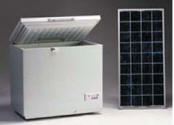 Good article on
efficient, solar powered refrigerators. Good article on
efficient, solar powered refrigerators.
Most run directly on 12 VDC, and are easy on solar PV systems.
|
| Make a Fridge?
Description of the fridge making kit and instructions for making
a fridge from it ...
More Details (pdf)
Another kit fridge -- DIY
System Kits...
|
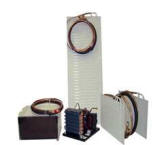 This is just a thought.
NovaKool (maybe others?) offers a kit for people who want to make
their own fridges. It consists of a compressor, evaporator,
condenser, controls, and pre-charged tubing -- all the guts of a
fridge. It is intended for boat or RV owners who want a built in
fridge. It uses the DanFoss compressor, which is reputed to be
efficient. This is just a thought.
NovaKool (maybe others?) offers a kit for people who want to make
their own fridges. It consists of a compressor, evaporator,
condenser, controls, and pre-charged tubing -- all the guts of a
fridge. It is intended for boat or RV owners who want a built in
fridge. It uses the DanFoss compressor, which is reputed to be
efficient.
If you wanted to make a very efficient fridge, this kit would allow
you allow you to build the box with as much insulation as you want,
it could be top opening, and the compressor could be located in an
optimal spot. On just a rough guess from their specs, you might get
down to 0.1 KWH per day for a very well insulated 8 cubic foot
fridge. Unfortunately the kit is not cheap, but this still might
pay well for off-grid PV users.
If anyone has tried this (or similar), please let me know how it
turned out --
Gary |
| Passive Refrigerator/Icebox
http://fourmileisland.com/IceBox.htm
Note: I would not try this unless you have a lot of time to
tinker -- I am guessing there is a significant learning curve
attached to getting one of these operating well.
|
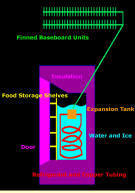 This fridge uses a well
insulated 300 gallon water/ice container that is cooled by an
outdoor finned tube baseboard unit to supply year round
refrigeration with no energy use. No moving parts. This fridge uses a well
insulated 300 gallon water/ice container that is cooled by an
outdoor finned tube baseboard unit to supply year round
refrigeration with no energy use. No moving parts.
Other interesting projects on the same site.
|
| Off
Grid Appliances |
Finding
efficient appliances for off grid can be difficult, since the
power draw is very important, but you still want an appliance that
does the job well -- this section will collect a few appliances
that off-grid people favor:
|
| How to build a wood fired
clothes dryer
Full details ...
Ray's
site has many other interesting projects...
|
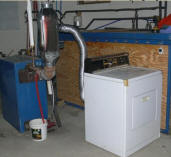 Ray was looking for a way to dry clothes
in the winter for his off-grid home. He came up with this design
that captures heat from a wood burning boiler or stove chimney so
that the only electricity needed for the dryer is motor and
controls. He provides full details for converting an electric
clothes dryer to use heat from burning wood. Ray was looking for a way to dry clothes
in the winter for his off-grid home. He came up with this design
that captures heat from a wood burning boiler or stove chimney so
that the only electricity needed for the dryer is motor and
controls. He provides full details for converting an electric
clothes dryer to use heat from burning wood. |
| Other
Interesting PV Applications |
| Solar Scooter
Full Scooter Plans from Don
Article on the scooter in Tree Hugger with some additional
pictures:
http://www.treehugger.com
|
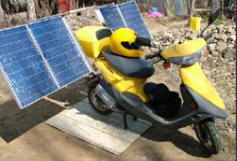 A solar scooter by Don
Dunklee. Street legal, affordable and dependable. A solar scooter by Don
Dunklee. Street legal, affordable and dependable.
Thanks to Don for making the plans available!
|
| "Big Belly" solar powered trash bin
http://bigbellysolar.com/
|

"Big Belly" is a trash bin with built in compaction. It is
solar powered and requires no power connection.
The compactor reduces trash volume by up to 8 times -- this
reduces the number of garbage truck pickups, which in turn reduces
energy use and GHG emissions. Big Belly has very carefully
designed power management, and can go for many cloudy days without
running out of power.
|
|
Roof-Integrated PV From Sunbeam To Standing
Seam
William Ball
How to get articles from
Home Power ...
|
 Home Power Magazine article, issue 105 Home Power Magazine article, issue 105
Description of using Uni-Solar
laminated PV bonded to a metal standing seam roof produces an
almost invisible PV installation. Detailed description of the
laminated PV installation and of the PV system
|
|
A DIY solar powered pool pump installation
All the
details on design, build, and economics...
|
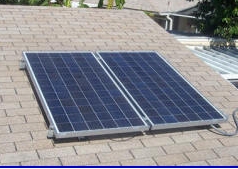 Bruce cut his total home
electricity usage by 25% using this PV powered pump for his pool. Bruce cut his total home
electricity usage by 25% using this PV powered pump for his pool.
The system uses two 170 watt PV panels to power a Speck Swimming
Pool and Spa pump through a Lorentz controller.
All the
details on design, build, and economics...
|
| Build A Simple Solar Powered Outdoor
Light, Jeffery Yago, Backwoods Magazine
www.backwoodshome.com/articles2/yago92.html
|
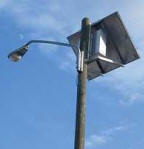 Backwoods Magazine Article on building a
solar PV powered "street light". Backwoods Magazine Article on building a
solar PV powered "street light". |
|
The Biggest Solar Electric Boat this Side of
the Mississippi
Steve Cooper
How to
get articles from Home Power ...
|
 Home Power Magazine article, issue 57 Home Power Magazine article, issue 57
Interesting article on using solar PV to provide auxiliary power
on a 30 ft sailboat.
|
PV and EV -- My Solar-Electric House and
Car
Mark Jensen
Home Power Magazine Article, Issue 113
How to get articles
from Home Power ...
|
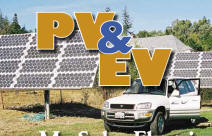 Good Home Power article.
Mark describes the large PV system that runs his house, as well as
keeping his Toyota RAV 4 EV (Electrical Vehicle) charged. Good Home Power article.
Mark describes the large PV system that runs his house, as well as
keeping his Toyota RAV 4 EV (Electrical Vehicle) charged.
These EV's are no longer offered by Toyota, and after reading the
article, one wonders why? |
| Energy Tile
-- PV modules that look like roof shingles
http://www.bp.com/...
|
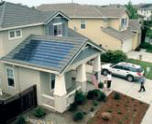 PV modules that resemble roof shingles
and tend to blend in with the roof. PV modules that resemble roof shingles
and tend to blend in with the roof. |
Electricity
From Solar Generated Steam
There is a persistent interest in schemes that
use concentrating solar collectors to make steam, which is then
used to drive a steam engine or steam turbine, which in turn
drives an electrical generator.
One of the advantages of this plan is that solar thermal
collectors to make steam are several times more efficient than PV
modules, but this is somewhat offset by the low efficiency of
steam engines.
Just below is all I could find on this area -- if you know of more
information, please let me know.
|
| Note: Even though
there is quite a bit of interest in this area, I was not able to
find much on small scale projects -- if you have experience in this
area, or find any interesting material, please let me know. |
Zenman Energy...
|
 This is a small
group trying to develop and open source, small scale electricity
generation system based on concentrating solar thermal collectors
and the Green
Steam Engine to power a generator. This is a small
group trying to develop and open source, small scale electricity
generation system based on concentrating solar thermal collectors
and the Green
Steam Engine to power a generator. |
DIY
Concentrating Solar Collectors...
|
 The link at the
left is to our page on concentrating solar collectors that can be
tackled as DIY projects. The link at the
left is to our page on concentrating solar collectors that can be
tackled as DIY projects.
Some of these might be suitable for steam powered electrical
generation. |
A Concentrated Solar Thermal Energy System,
Christopher Newton, Florida State University
|
 This is a Masters thesis project that goes through
the design and build of a small concentrating solar collector, steam
generation system, and the build of a turbine. This is a Masters thesis project that goes through
the design and build of a small concentrating solar collector, steam
generation system, and the build of a turbine.
You may or may not want to build this particular design, but going
through it gives a feel for how much work is involved in one of
these systems.
This is from www.RedRok.com |
| Generating steam with George's parabolic trough
collector... |
 George has been
doing some interesting experiments using his parabolic trough
collectors to generate steam. George has been
doing some interesting experiments using his parabolic trough
collectors to generate steam.
It will be interesting to see where this leads. |
|
Small Steam Engines and Turbines
Green
Steam Engine ...
Green
Turbine...
Mike
Brown Steam Engines...
Strath Steam -- I'm not sure if they are still in
business, but there website which has been archived on the
Wayback Machine has quite a bit of useful information...
Also check YouTube for videos on the Strath Steam Engine.
|
 Small steam engines and steam turbines
are few and far between -- these are a few places to start looking. Small steam engines and steam turbines
are few and far between -- these are a few places to start looking.
|
Commercial Scale Solar Thermal
Electricity
Wikipedia on solar thermal power plants...
NREL:
Concentrating Solar Power: Energy from Mirrors
Ivanph
project.... |
 There are many
examples of successful large commercial electrical generation plants
that use large arrays of parabolic collectors heating fluid at their
focus, or use large fields of heliostats that reflect energy onto a
tower mounted receiver. Some of these plants even include molten
salt energy storage so they can continue to supply power after the
sun goes down. There are many
examples of successful large commercial electrical generation plants
that use large arrays of parabolic collectors heating fluid at their
focus, or use large fields of heliostats that reflect energy onto a
tower mounted receiver. Some of these plants even include molten
salt energy storage so they can continue to supply power after the
sun goes down.
|
Make
Your Own PV
Here are some detailed articles on how to build
your own PV panels from individual PV cells.
If you think that you want to roll your own PV panel, these are
the best descriptions I could find -- some of them are very
detailed.
Careful weather sealing needs to be addressed. |
| Caution:
bogus books on making your own PV panels |
I've noticed that a number of books have popped up
on the Internet and on ebay that promise to tell you in detail how
to easily make PV panels (or wind turbines).
Many of these are scams that contain little or no
useful information. I don't know how you tell the good from
the bad, but the two links below and the ones on the wind page
provide quite a bit of how-to detail for no charge, so I'd start
with these.
|
| Home
Build Solar System
Full
Details... (pdf)
|
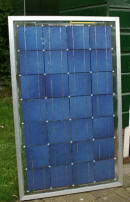 This is a very well done article on building not only
your own PV panels, but adding the additional components to make a
full system. This is a very well done article on building not only
your own PV panels, but adding the additional components to make a
full system.
Home Build
Solar System is Hans website, and has additional materials
on this and other renewable energy projects.
|
| Solar Panel
Do-It-Yourself
http://www.xs4all.nl/~hante/index-en.html
|
 This website from Hante provides very detailed and
carefully thought out techniques for assembling your own PV panels
from individual cells. This website from Hante provides very detailed and
carefully thought out techniques for assembling your own PV panels
from individual cells.
There is also material on adding the other components needed to
make a full system.
|
How I built an electricity producing
Solar Panel,
Mike
http://www.mdpub.com/SolarPanel/index.html
|
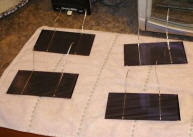 Another quite detailed run down on making
your own PV panels from individual solar cells purchased on ebay. Another quite detailed run down on making
your own PV panels from individual solar cells purchased on ebay. |
Homemade Solar Panels
Homemade Solar PV Panel...
|
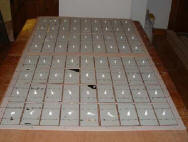 This is a fairly detailed post describing
how to build your own PV panels from individual solar cells. This is a fairly detailed post describing
how to build your own PV panels from individual solar cells.
I've also heard a couple stories about early failure of homemade
panels from moisture penetration due to weather exposure -- don't
know what the design of these panels was. |
| Home DIY
Solar
http://www.homediysolar.com
|
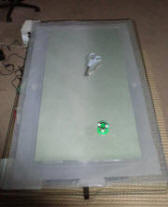 Another good and free source of information on how to
make PV panels. Another good and free source of information on how to
make PV panels.
Sean uses a vacuum bag technique to seal the PV panel together.
|
|
|


 Before you embark on any of
the solar projects listed below, you MUST do a solar site survey.
Before you embark on any of
the solar projects listed below, you MUST do a solar site survey. A consumer guide for selecting a PV
system. Quite a bit of useful information whether you intend to
have the system installed, or install it yourself.
A consumer guide for selecting a PV
system. Quite a bit of useful information whether you intend to
have the system installed, or install it yourself. A couple of introductory
articles from Home Power magazine
A couple of introductory
articles from Home Power magazine This
is a set of articles by Jeff Yago that goes through the basics of
designing and installing a solar electric system.
This
is a set of articles by Jeff Yago that goes through the basics of
designing and installing a solar electric system. This is a very helpful reference and
catalog for renewable energy systems. It covers PV, wind and small
hydro with emphasis on PV.
This is a very helpful reference and
catalog for renewable energy systems. It covers PV, wind and small
hydro with emphasis on PV.
 Home Power magazine has published many
articles on PV basics, PV systems, and PV components.
Home Power magazine has published many
articles on PV basics, PV systems, and PV components.
 An easy calculator you can use to find
out how much power you will get from a PV installation in your
area. Also very helpful for panel aiming studies.
An easy calculator you can use to find
out how much power you will get from a PV installation in your
area. Also very helpful for panel aiming studies. This appears to be a good
tool for estimating the economic return for installing a PV system
for your area.
This appears to be a good
tool for estimating the economic return for installing a PV system
for your area. Very nice PV array sizing
tool and solar radiation tool for Europe and Africa.
Very nice PV array sizing
tool and solar radiation tool for Europe and Africa. A good primer
on what's involved in planning for an living in an off-grid home
with solar electricity generation.
A good primer
on what's involved in planning for an living in an off-grid home
with solar electricity generation.  The printed version of the
Backwoods Solar Catalog has a lot of good educational and reference
material. Available on request from their website.
The printed version of the
Backwoods Solar Catalog has a lot of good educational and reference
material. Available on request from their website. Mother Earth
News Article
Mother Earth
News Article
 So, how much output will a
(say) 1 KW rated PV setup produce? This Home Energy Magazine
article reports actual measurements for 19 real PV systems.
So, how much output will a
(say) 1 KW rated PV setup produce? This Home Energy Magazine
article reports actual measurements for 19 real PV systems. A very good and detailed
reference on designing and installing PV systems -- the best that I
know of.
A very good and detailed
reference on designing and installing PV systems -- the best that I
know of.
 A lot of helpful and fairly detailed
information on planning, designing, and installing a PV system that
is safe and meets codes.
A lot of helpful and fairly detailed
information on planning, designing, and installing a PV system that
is safe and meets codes.
 The 1BOG organization puts together a
group of people in a city who want to install PV systems, and
negotiates a group discount.
The 1BOG organization puts together a
group of people in a city who want to install PV systems, and
negotiates a group discount.
 This is a simple and
easy to build solar PV system that will provide some emergency
power during power outages, and can also be used for camping or
for supplying power to a few things around the house on a routine
basis.
This is a simple and
easy to build solar PV system that will provide some emergency
power during power outages, and can also be used for camping or
for supplying power to a few things around the house on a routine
basis. Jeff describes how
to go about designing and installing a small, 12 VDC solar electric
system for a cabin.
Jeff describes how
to go about designing and installing a small, 12 VDC solar electric
system for a cabin. Interesting article by Jeff
Yago on putting together self sufficient trailer mounted PV rig. It
can be used for camping or emergencies.
Interesting article by Jeff
Yago on putting together self sufficient trailer mounted PV rig. It
can be used for camping or emergencies.
 This is a really nice system that fits into a pickup
truck. The 320 watts of PV fit on the existing roof rack, and the
400 amp-hours of batteries in the side compartments. A pair of
This is a really nice system that fits into a pickup
truck. The 320 watts of PV fit on the existing roof rack, and the
400 amp-hours of batteries in the side compartments. A pair of Morningstar charge controllers complete the system.
Morningstar charge controllers complete the system.  Good basic article on setting up a small cabin so it
can be powered by a small PV system.
Good basic article on setting up a small cabin so it
can be powered by a small PV system. This is another example of putting
together a small, standalone PV system on a shoestring.
This is another example of putting
together a small, standalone PV system on a shoestring.
 Home Power Magazine article,
issue 75
Home Power Magazine article,
issue 75
 Home Power Magazine article, issue 100
Home Power Magazine article, issue 100
 Home Power Magazine article,
issue 47
Home Power Magazine article,
issue 47
 Home Power Magazine article,
issue 93
Home Power Magazine article,
issue 93
 Kevin built a small, portable PV
system to provide some power for lights, radio, cell phone
charging,... on camping trips.
Kevin built a small, portable PV
system to provide some power for lights, radio, cell phone
charging,... on camping trips. Home Power Magazine article,
issue 96
Home Power Magazine article,
issue 96
 Home Power Magazine article,
issue 90
Home Power Magazine article,
issue 90
 A good write-up on designing,
installing, and maintaining a PV system for an RV. Lots of emphasis
on choosing and maintaining the batteries.
A good write-up on designing,
installing, and maintaining a PV system for an RV. Lots of emphasis
on choosing and maintaining the batteries. Home Power Magazine article, issue 92
Home Power Magazine article, issue 92
 A good Home Power magazine
article on sizing and living with an off grid PV and wind system for
an Earthship.
A good Home Power magazine
article on sizing and living with an off grid PV and wind system for
an Earthship.  Mother Earth
News Article, Issue 199
Mother Earth
News Article, Issue 199
 Home Power Magazine article, issue 99
Home Power Magazine article, issue 99
 Home Power Magazine article,
issue 98
Home Power Magazine article,
issue 98
 Home Power Magazine article, issue 106
Home Power Magazine article, issue 106
 An article by Jeff Yago on batteries
for off-grid solar electric systems.
An article by Jeff Yago on batteries
for off-grid solar electric systems.  This
is a very detailed account of planning, designing and installing
our own new 2150 watt grid-tied PV system.
This
is a very detailed account of planning, designing and installing
our own new 2150 watt grid-tied PV system.
 This is a very detailed account of
our project to recondition an Elec-Trak electric tractor. All the
fascinating
This is a very detailed account of
our project to recondition an Elec-Trak electric tractor. All the
fascinating details on scraping and painting,
...
details on scraping and painting,
... This is a really well done grid-tied PV
project by Doug Kalmer. It is a 4.6 KW array using Enphase micro
inverters.
This is a really well done grid-tied PV
project by Doug Kalmer. It is a 4.6 KW array using Enphase micro
inverters.
 Guy Marsden describes the whole process of selecting,
designing and installing his new grid-tie PV system. Since Guy and
friends did the whole installation, there is a lot of detail.
Guy Marsden describes the whole process of selecting,
designing and installing his new grid-tie PV system. Since Guy and
friends did the whole installation, there is a lot of detail.  Very good Instructables writeup on a 6.3 KW grid
tied PV array.
Very good Instructables writeup on a 6.3 KW grid
tied PV array. A very nicely done grid tied PV
system using micro inverters in West Virginia.
A very nicely done grid tied PV
system using micro inverters in West Virginia. This
is a very nice and detailed five part blog from Kevin on planning,
permitting, and installing a micro inverter based 3.84KW grid-tie
system.
This
is a very nice and detailed five part blog from Kevin on planning,
permitting, and installing a micro inverter based 3.84KW grid-tie
system.
 Nice personal website describing a grid
tied PV installation. Provides over a year of performance data.
Pictures of installation with good detail on panel mounting.
Nice personal website describing a grid
tied PV installation. Provides over a year of performance data.
Pictures of installation with good detail on panel mounting. Good Home Power Article on authors
attempt to be "Carbon neutral" through conservation, less fossil
fuel, solar active and passive strategies, and a grid tied PV
system. Most of the article details his experiences with installing
a grid tied PV system in Ashland, OR -- a pretty positive experience
all-around.
Good Home Power Article on authors
attempt to be "Carbon neutral" through conservation, less fossil
fuel, solar active and passive strategies, and a grid tied PV
system. Most of the article details his experiences with installing
a grid tied PV system in Ashland, OR -- a pretty positive experience
all-around. Home Power Magazine article,
issue 95
Home Power Magazine article,
issue 95
 An article in Backwoods Home magazine by
Jeff Yago on a grid tie system with some useful design and install
information.
An article in Backwoods Home magazine by
Jeff Yago on a grid tie system with some useful design and install
information. Home Power Magazine article, issue 99
Home Power Magazine article, issue 99
 Home Power Magazine article, issue 105
Home Power Magazine article, issue 105
 Home Power Magazine article, issue 106
Home Power Magazine article, issue 106
 Home Power Magazine article,
issue 97
Home Power Magazine article,
issue 97
 This is a many page post on Northern Arizona Wind
& Sun forum. It covers the installation of an 8.1KW grid-tied
PV system.
This is a many page post on Northern Arizona Wind
& Sun forum. It covers the installation of an 8.1KW grid-tied
PV system.  Some detailed
pictures of a large PV array at Craters of the Moon National
Monument. The clean mounting system and simple wiring and equipment
mounting might provide some helpful ideas for your system.
Some detailed
pictures of a large PV array at Craters of the Moon National
Monument. The clean mounting system and simple wiring and equipment
mounting might provide some helpful ideas for your system. This is an interesting grid-tie, microinverter system
that literally plugs into a wall outlet.
This is an interesting grid-tie, microinverter system
that literally plugs into a wall outlet. This is a huge solar electric
installation at the Cold Springs Station on Hwy 50 in a very lonely
part of the Nevada desert. It is a 30KW grid tied PV installation
that sells excess power to the utility.
This is a huge solar electric
installation at the Cold Springs Station on Hwy 50 in a very lonely
part of the Nevada desert. It is a 30KW grid tied PV installation
that sells excess power to the utility. Westinghouse announced the release of
solar PV kits for DIY installation. The kit includes the PV
modules, microinverters, parts for roof mounting, and the other bits
needed to complete the system.
Westinghouse announced the release of
solar PV kits for DIY installation. The kit includes the PV
modules, microinverters, parts for roof mounting, and the other bits
needed to complete the system.  This is a similar microinverter based
DIY PV system kit from Clarian. It was announced some time back,
but is not yet available for sale -- hopefully soon.
This is a similar microinverter based
DIY PV system kit from Clarian. It was announced some time back,
but is not yet available for sale -- hopefully soon. These are starter kits that several of
the PV retail suppliers have been offering based on the Enphase
microinverter. These systems typically consist of one PV panel, one
Enphase microinveter, and possibly a rack and some other odds and
end.
These are starter kits that several of
the PV retail suppliers have been offering based on the Enphase
microinverter. These systems typically consist of one PV panel, one
Enphase microinveter, and possibly a rack and some other odds and
end.
 This is a way to do a small, under the radar,
grid-tied PV system that uses a China import grid-tie inverter.
This is a way to do a small, under the radar,
grid-tied PV system that uses a China import grid-tie inverter.
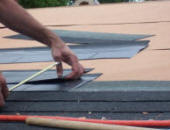

 A very good personal website on designing
and installing a PV and wind system that is grid tied with battery
backup.
A very good personal website on designing
and installing a PV and wind system that is grid tied with battery
backup.
 Home Power Article, issue 94
Home Power Article, issue 94
 Very good paper with results
on testing a simple scheme that uses one axis tracking coupled with
high acceptance angle V troughs to provide average daily
concentrations around of around 2. Simple aluminum cooling fins
are used to keep cell temperature comparable to non-concentrating
commercial PV panels.
Very good paper with results
on testing a simple scheme that uses one axis tracking coupled with
high acceptance angle V troughs to provide average daily
concentrations around of around 2. Simple aluminum cooling fins
are used to keep cell temperature comparable to non-concentrating
commercial PV panels. Simple tracker and
concentrator design might nearly double PV panel output.
Simple tracker and
concentrator design might nearly double PV panel output.
 Interesting 1992 paper on PV powered
pumping for irrigation wire. Good analysis of system.
Interesting 1992 paper on PV powered
pumping for irrigation wire. Good analysis of system.
 Light duty solar trackers that you can
make from computer parts and ABS tubing.
Light duty solar trackers that you can
make from computer parts and ABS tubing.
 Simplified Building Concepts offers
several systems that use standard galvanized metal pipe with
fittings that allow the pipe to be configured for just about
anything, including PV panel mount racks. Looks like a very
flexible and easy to use system, and people report that they are
willing to help you make your project work.
Simplified Building Concepts offers
several systems that use standard galvanized metal pipe with
fittings that allow the pipe to be configured for just about
anything, including PV panel mount racks. Looks like a very
flexible and easy to use system, and people report that they are
willing to help you make your project work.  This is a nice and simple system that
uses a combination of commercially available aluminum rails attached
to large treated timbers that anchor the front and back of the PV
array.
This is a nice and simple system that
uses a combination of commercially available aluminum rails attached
to large treated timbers that anchor the front and back of the PV
array. Some detailed pictures of a PV array
mount system using galvanized steel pipes coupled with standard
industrial fittings to make a sturdy, simple and clean looking mount
system.
Some detailed pictures of a PV array
mount system using galvanized steel pipes coupled with standard
industrial fittings to make a sturdy, simple and clean looking mount
system. Pretty good looking and well
anchored wood mount for PV panels.
Pretty good looking and well
anchored wood mount for PV panels. This is a pretty good and detailed
installation tutorial for installers.
This is a pretty good and detailed
installation tutorial for installers. A set of quite detailed
suggested practices for wiring PV systems to comply with the
National Electric Code.
A set of quite detailed
suggested practices for wiring PV systems to comply with the
National Electric Code. This is a very helpful set
of guidelines on PV system equipment, and particularly on wiring of
PV systems.
This is a very helpful set
of guidelines on PV system equipment, and particularly on wiring of
PV systems. The NABCEB offers certifications for
installers of PV systems.
The NABCEB offers certifications for
installers of PV systems. A Power Point set of
guidelines for roof mounted PV installations.
A Power Point set of
guidelines for roof mounted PV installations. Home Power magazine two part article in
issues 108 and 109 on installing a pole mounted PV array.
Home Power magazine two part article in
issues 108 and 109 on installing a pole mounted PV array.
 Home Power Magazine article, issue 132, Aug-Sept
2009.
Home Power Magazine article, issue 132, Aug-Sept
2009.

 A collection of helpful articles and
references for DIYers on PV systems.
A collection of helpful articles and
references for DIYers on PV systems.
 Home Power Magazine article, issue 106
Home Power Magazine article, issue 106
 This is a good rundown on the type of batteries
normally used in PV systems.
This is a good rundown on the type of batteries
normally used in PV systems. This is a very
interesting paper showing the use of PV panels as part of a shade
canopy that provides shade for living space that was overheating and
generates solar electricity as well.
This is a very
interesting paper showing the use of PV panels as part of a shade
canopy that provides shade for living space that was overheating and
generates solar electricity as well. This
article describes the use of bifacial PV modules for building sun
shade structures that let a controlled amount of light to penetrate
the shaded area and simultanously harvest solar electricity.
This
article describes the use of bifacial PV modules for building sun
shade structures that let a controlled amount of light to penetrate
the shaded area and simultanously harvest solar electricity. A
nice collection of solar shade canopy exmaples.
A
nice collection of solar shade canopy exmaples. Brief description
of a nice pergola constructed with PV panels over a wood pergola
framework.
Brief description
of a nice pergola constructed with PV panels over a wood pergola
framework. These are just a
few more random pictures of
These are just a
few more random pictures of  Ceiling fans with "Gossamer Wind"
technology blades move about 40% more air for the same power use.
Ceiling fans with "Gossamer Wind"
technology blades move about 40% more air for the same power use. These evaporative coolers
use low HP 12V fans that can be powered by PV arrays.
These evaporative coolers
use low HP 12V fans that can be powered by PV arrays. Energy ratings
and energy use for appliances. Energy advice and online audit for
homes. Energy star appliances and homes.
Energy ratings
and energy use for appliances. Energy advice and online audit for
homes. Energy star appliances and homes.
 SunDanzer
SunDanzer This
refrigerator, which is a converted chest type freezer uses only
about 0.1 KWH per day. See the article for details. Latest update
includes a design for a low standby power thermostat.
This
refrigerator, which is a converted chest type freezer uses only
about 0.1 KWH per day. See the article for details. Latest update
includes a design for a low standby power thermostat. Good article on
efficient, solar powered refrigerators.
Good article on
efficient, solar powered refrigerators.
 This is just a thought.
NovaKool (maybe others?) offers a kit for people who want to make
their own fridges. It consists of a compressor, evaporator,
condenser, controls, and pre-charged tubing -- all the guts of a
fridge. It is intended for boat or RV owners who want a built in
fridge. It uses the DanFoss compressor, which is reputed to be
efficient.
This is just a thought.
NovaKool (maybe others?) offers a kit for people who want to make
their own fridges. It consists of a compressor, evaporator,
condenser, controls, and pre-charged tubing -- all the guts of a
fridge. It is intended for boat or RV owners who want a built in
fridge. It uses the DanFoss compressor, which is reputed to be
efficient. This fridge uses a well
insulated 300 gallon water/ice container that is cooled by an
outdoor finned tube baseboard unit to supply year round
refrigeration with no energy use. No moving parts.
This fridge uses a well
insulated 300 gallon water/ice container that is cooled by an
outdoor finned tube baseboard unit to supply year round
refrigeration with no energy use. No moving parts.
 Ray was looking for a way to dry clothes
in the winter for his off-grid home. He came up with this design
that captures heat from a wood burning boiler or stove chimney so
that the only electricity needed for the dryer is motor and
controls. He provides full details for converting an electric
clothes dryer to use heat from burning wood.
Ray was looking for a way to dry clothes
in the winter for his off-grid home. He came up with this design
that captures heat from a wood burning boiler or stove chimney so
that the only electricity needed for the dryer is motor and
controls. He provides full details for converting an electric
clothes dryer to use heat from burning wood. A solar scooter by Don
Dunklee. Street legal, affordable and dependable.
A solar scooter by Don
Dunklee. Street legal, affordable and dependable.

 Home Power Magazine article, issue 105
Home Power Magazine article, issue 105
 Bruce cut his total home
electricity usage by 25% using this PV powered pump for his pool.
Bruce cut his total home
electricity usage by 25% using this PV powered pump for his pool. Backwoods Magazine Article on building a
solar PV powered "street light".
Backwoods Magazine Article on building a
solar PV powered "street light". Home Power Magazine article, issue 57
Home Power Magazine article, issue 57
 Good Home Power article.
Mark describes the large PV system that runs his house, as well as
keeping his Toyota RAV 4 EV (Electrical Vehicle) charged.
Good Home Power article.
Mark describes the large PV system that runs his house, as well as
keeping his Toyota RAV 4 EV (Electrical Vehicle) charged. PV modules that resemble roof shingles
and tend to blend in with the roof.
PV modules that resemble roof shingles
and tend to blend in with the roof. This is a small
group trying to develop and open source, small scale electricity
generation system based on concentrating solar thermal collectors
and the
This is a small
group trying to develop and open source, small scale electricity
generation system based on concentrating solar thermal collectors
and the  The link at the
left is to our page on concentrating solar collectors that can be
tackled as DIY projects.
The link at the
left is to our page on concentrating solar collectors that can be
tackled as DIY projects.  This is a Masters thesis project that goes through
the design and build of a small concentrating solar collector, steam
generation system, and the build of a turbine.
This is a Masters thesis project that goes through
the design and build of a small concentrating solar collector, steam
generation system, and the build of a turbine. George has been
doing some interesting experiments using his parabolic trough
collectors to generate steam.
George has been
doing some interesting experiments using his parabolic trough
collectors to generate steam. Small steam engines and steam turbines
are few and far between -- these are a few places to start looking.
Small steam engines and steam turbines
are few and far between -- these are a few places to start looking. There are many
examples of successful large commercial electrical generation plants
that use large arrays of parabolic collectors heating fluid at their
focus, or use large fields of heliostats that reflect energy onto a
tower mounted receiver. Some of these plants even include molten
salt energy storage so they can continue to supply power after the
sun goes down.
There are many
examples of successful large commercial electrical generation plants
that use large arrays of parabolic collectors heating fluid at their
focus, or use large fields of heliostats that reflect energy onto a
tower mounted receiver. Some of these plants even include molten
salt energy storage so they can continue to supply power after the
sun goes down. This is a very well done article on building not only
your own PV panels, but adding the additional components to make a
full system.
This is a very well done article on building not only
your own PV panels, but adding the additional components to make a
full system.
 This website from Hante provides very detailed and
carefully thought out techniques for assembling your own PV panels
from individual cells.
This website from Hante provides very detailed and
carefully thought out techniques for assembling your own PV panels
from individual cells.
 Another quite detailed run down on making
your own PV panels from individual solar cells purchased on ebay.
Another quite detailed run down on making
your own PV panels from individual solar cells purchased on ebay. This is a fairly detailed post describing
how to build your own PV panels from individual solar cells.
This is a fairly detailed post describing
how to build your own PV panels from individual solar cells. Another good and free source of information on how to
make PV panels.
Another good and free source of information on how to
make PV panels.